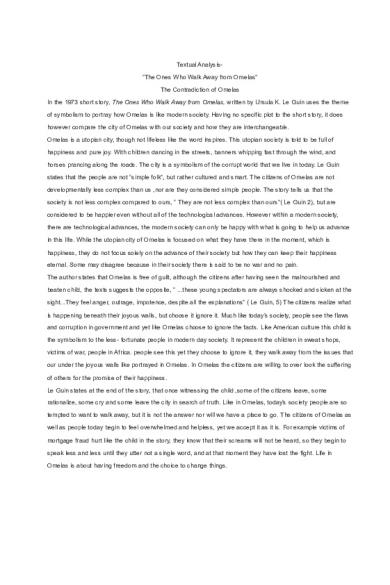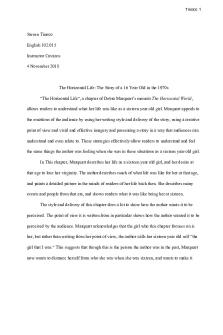Textual Analysis PDF

| Title | Textual Analysis |
|---|---|
| Author | Kenz Elise |
| Course | Introduction to English II |
| Institution | Kennesaw State University |
| Pages | 2 |
| File Size | 47.5 KB |
| File Type | |
| Total Downloads | 91 |
| Total Views | 128 |
Summary
Analysis...
Description
Textual Analysis“The Ones Who Walk Away from Omelas” The Contradiction of Omelas In the 1973 short story, The Ones Who Walk Away from Omelas, written by Ursula K. Le Guin uses the theme of symbolism to portray how Omelas is like modern society. Having no specific plot to the short story, it does however compare the city of Omelas with our society and how they are interchangeable. Omelas is a utopian city, though not lifeless like the word inspires. This utopian society is told to be full of happiness and pure joy. With children dancing in the streets, banners whipping fast through the wind, and horses prancing along the roads. The city is a symbolism of the corrupt world that we live in today. Le Guin states that the people are not “simple folk”, but rather cultured and smart. The citizens of Omelas are not developmentally less complex than us ,nor are they considered simple people. The story tells us that the society is not less complex compared to ours, “ They are not less complex than ours”( Le Guin 2), but are considered to be happier even without all of the technological advances. However within a modern society, there are technological advances, the modern society can only be happy with what is going to help us advance in this life. While the utopian city of Omelas is focused on what they have there in the moment, which is happiness, they do not focus solely on the advance of their society but how they can keep their happiness eternal. Some may disagree because in their society there is said to be no war and no pain. The author states that Omelas is free of guilt, although the citizens after having seen the malnourished and beaten child, the texts suggests the opposite, “ ...these young spectators are always shocked and sicken at the sight...They feel anger, outrage, impotence, despite all the explanations” ( Le Guin, 5) The citizens realize what is happening beneath their joyous walls, but choose it ignore it. Much like today’s society, people see the flaws and corruption in government and yet like Omelas choose to ignore the facts. Like American culture this child is the symbolism to the less- fortunate people in modern day society. It represent the children in sweat shops, victims of war, people in Africa. people see this yet they choose to ignore it, they walk away from the issues that our under the joyous walls like portrayed in Omelas. In Omelas the citizens are willing to over look the suffering of others for the promise of their happiness. Le Guin states at the end of the story, that once witnessing the child ,some of the citizens leave, some rationalize, some cry and some leave the city in search of truth. Like in Omelas, today’s society people are so tempted to want to walk away, but it is not the answer nor will we have a place to go. The citizens of Omelas as well as people today begin to feel overwhelmed and helpless, yet we accept it as it is. For example victims of mortgage fraud hurt like the child in the story, they know that their screams will not be heard, so they begin to speak less and less until they utter not a single word, and at that moment they have lost the fight. Life in Omelas is about having freedom and the choice to change things.
Omelas is a direct representation of American culture today. Both society are filled with expectations that effect not only the outcome of every action we take, but it also effects the view that is then taken of society. If there is to be change in society, then people need not to be like the citizens of Omelas, stricken with fear and guilt then suppressed no longer on the surface. They did not make the effort, to make the suffering of the child less, because they feared they would then lose their happy and abundant life that they had been given....
Similar Free PDFs

Textual Analysis
- 3 Pages

Textual Analysis
- 2 Pages

Textual Analysis - Podcast
- 3 Pages

Textual Analysis Exercise
- 3 Pages

Perez Hilton Textual Analysis
- 16 Pages

Textual Analysis Outline
- 4 Pages

The Crito - Textual Analysis
- 5 Pages

Sitcom Textual Analysis
- 2 Pages

CYB103 Textual analysis
- 7 Pages

Textual Rhetorical Analysis
- 3 Pages
Popular Institutions
- Tinajero National High School - Annex
- Politeknik Caltex Riau
- Yokohama City University
- SGT University
- University of Al-Qadisiyah
- Divine Word College of Vigan
- Techniek College Rotterdam
- Universidade de Santiago
- Universiti Teknologi MARA Cawangan Johor Kampus Pasir Gudang
- Poltekkes Kemenkes Yogyakarta
- Baguio City National High School
- Colegio san marcos
- preparatoria uno
- Centro de Bachillerato Tecnológico Industrial y de Servicios No. 107
- Dalian Maritime University
- Quang Trung Secondary School
- Colegio Tecnológico en Informática
- Corporación Regional de Educación Superior
- Grupo CEDVA
- Dar Al Uloom University
- Centro de Estudios Preuniversitarios de la Universidad Nacional de Ingeniería
- 上智大学
- Aakash International School, Nuna Majara
- San Felipe Neri Catholic School
- Kang Chiao International School - New Taipei City
- Misamis Occidental National High School
- Institución Educativa Escuela Normal Juan Ladrilleros
- Kolehiyo ng Pantukan
- Batanes State College
- Instituto Continental
- Sekolah Menengah Kejuruan Kesehatan Kaltara (Tarakan)
- Colegio de La Inmaculada Concepcion - Cebu





